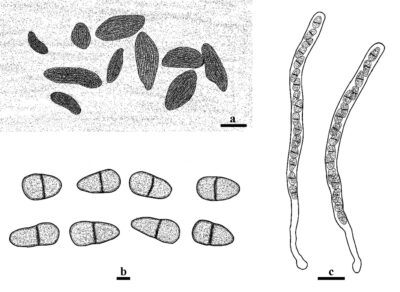Fungalpedia – Note 417, Hysterodifractum
Hysterodifractum D.A.C. Almeida, Gusmão & A.N. Mill.
Citation when using this data: Tibpromma et al. 2024 (in prep.) – Fungalpedia, Ascomycota.
Index Fungorum, Facesoffungi, MycoBank, GenBank, Fig. 1
Classification: Hysteriaceae, Hysteriales, Pleosporomycetidae, Dothideomycetes, Pezizomycotina, Ascomycota, Fungi.
Based on morphological and phylogenetic analysis of ITS, LSU, TUB, and TEF1-α, Hysterodifractum was introduced by De Almeida et al. (2014) as a monotypic genus within Hysteriaceae with the type species Hysterodifractum partisporum which was reported as a saprobe on twigs of unidentified plants in Brazil. Only one species was accepted in this genus, with its sexual morph. Hysterodifractum is characterized by black, carbonaceous, navicular, straight, or sometimes flexuous, with a longitudinal slit, smooth or slightly striated laterally ascomata, gregarious, lying at irregular angles, bitunicate, cylindrical, 16-spored, uniseriate to irregularly biseriate asci, pale brown, fusiform, smooth ascospores, disarticulating into part spores (Almeida et al. 2014). Hysterodifractum is phylogenetically closely related to Rhytidhysteron opuntiae; however, it is morphologically very different (Barr 1990, Almeida et al. 2014). Rhytidhysteron opuntiae has ellipsoid, 3-septate dictyosporous ascospores, usually with one longitudinal septum in the middle cell, whereas Hysterodifractum partisporum has didymospores (Almeida et al. 2014). Hysterodifractum differs from other genera in the Hysteriaceae with the ascospores that disarticulate into part-spores when mature (Almeida et al. 2014). Hysterodifractum can be distinguished from other genera based on its morphology and phylogeny.
Type species: Hysterodifractum partisporum D.A.C. Almeida, Gusmão & A.N. Mill.
Other accepted species: This genus is monotypic.
Figure 1 – Morphological features of Hysterodifractum partisporum. a Ascomata. b Ascospores. c Asci. Scale bars: a = 100 μm, b =2 μm, c =10 μm. Redrawn from De Almeida et al. (2014).
References
Entry by
Liu XF, Center for Yunnan Plateau Biological Resources Protection and Utilization, College of Biological Resource and Food Engineering, Qujing Normal University, Qujing, Yunnan 655011, China; Center of Excellence in Fungal Research, Mae Fah Luang University, Chiang Rai 57100, Thailand; School of Science, Mae Fah Luang University, Chiang Rai 57100, Thailand.
(Edited by Saowaluck Tibpromma, Samaneh Chaharmiri-Dokhaharani, & Achala R. Rathnayaka)
Published online 26 November 2024
